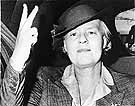
|
|
|

|

|

|

|
|
Click on an image to see a larger, more detailed picture.
|
|
|
|
|
| 1934: Triumph of the Will |

|
pg. 80 |

|
|
|
|
| |
 Among the most outspoken American critics of the Third Reich's persecution of Germany's Jews was newspaper columnist Dorothy Thompson. A journalist in Germany during the early days of the Hitler regime, she reported on the antisemitic atrocities of the new government. When news of the Holocaust reached the United States in December 1942, Thompson was one of the few Americans to call for concerted action to stop the genocide. Her pleas fell on deaf ears.
Among the most outspoken American critics of the Third Reich's persecution of Germany's Jews was newspaper columnist Dorothy Thompson. A journalist in Germany during the early days of the Hitler regime, she reported on the antisemitic atrocities of the new government. When news of the Holocaust reached the United States in December 1942, Thompson was one of the few Americans to call for concerted action to stop the genocide. Her pleas fell on deaf ears.
Photo: National Archives/United States Holocaust Memorial Museum Photo Archive
|
 Reichstag members enthusiastically salute Hitler after his address justifying the death of several dozen Nazis in the Night of the Long Knives on June 30,1934. The Blood Purge eradicated the leadership of the Brown Shirts (SA), the quasimilitary organization led by Ernst Röhm, along with scores of other potential enemies.
Reichstag members enthusiastically salute Hitler after his address justifying the death of several dozen Nazis in the Night of the Long Knives on June 30,1934. The Blood Purge eradicated the leadership of the Brown Shirts (SA), the quasimilitary organization led by Ernst Röhm, along with scores of other potential enemies.
Photo: Ullstein Bilderdienst
|
 The SA
The SA
The Nazi Party owed much of its early success to its brown-shirted army of violent thugs, the SA. The Sturmabteilung (Storm Troopers), or SA for short, was created to maintain order at meetings and protect Party speakers. In time it became much more than that. After the refounding of the Party in 1925, the SA developed into a powerful propaganda tool. Vowing to "win the streets" for the Party, SA men sold newspapers, distributed leaflets, posted placards, and marched at mass rallies. The SA also took delight in provoking violent confrontations with political opponents. Most SA men were street toughs who relied on fists, knives, clubs, and guns during brawls. Numbering almost four million men by June 1934, the SA's strength ironically became troublesome for Hitler. Its continued radicalism, talk of a "second revolution," and scheme to become the new "people's army" clashed with Hitler's plans. During the night of June 30, 1934 , Hitler unleashed an assassination campaign against the SA's top leadership. Among the most prominent victims slaughtered was SA chief Ernst Röhm. With the purge of the SA, its rival organization--the SS--rapidly rose in power in the Nazi state.
|
|

|

|

|

|
 May 2, 1934: Congressman Louis T. McFadden delivers an antisemitic speech on the floor of the United States House of Representatives.
May 2, 1934: Congressman Louis T. McFadden delivers an antisemitic speech on the floor of the United States House of Representatives.
|
 May 17, 1934: At New York's Madison Square Garden, thousands attend a pro-Nazi rally sponsored by the German-American Bund.
May 17, 1934: At New York's Madison Square Garden, thousands attend a pro-Nazi rally sponsored by the German-American Bund.
|
 June 9, 1934: The SD (Sicherheitsdienst; Security Service), an intelligence service of the SS, is now designated the sole intelligence service for the SS and Nazi Party.
June 9, 1934: The SD (Sicherheitsdienst; Security Service), an intelligence service of the SS, is now designated the sole intelligence service for the SS and Nazi Party.
|
 June 9, 1934: The Soviet Union, Poland, and Romania pledge to respect their common borders.
June 9, 1934: The Soviet Union, Poland, and Romania pledge to respect their common borders.
|
|
|
|
|
| 1934: Triumph of the Will |

|
pg. 80 |

|
|
The Holocaust Chronicle
© 2009 Publications International, Ltd.
|
|
